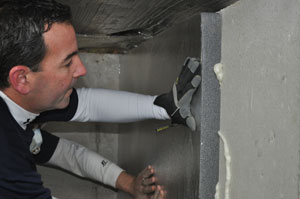In Business Since | License #
In Business Since | License #


Two barriers in one. SilverGlo™ rigid foam insulation from Dr. Energy Saver provides two energy-saving benefits, acting as both an air barrier and a thermal barrier.

What comes to mind when someone says "insulation?" Most of us think of fiberglass batts, visualizing spun glass fibers that look a lot like cotton candy. Other folks might envision shredded newspaper, the main ingredient in cellulose insulation.
Dr. Energy Saver uses a variety of insulation options, and one of the most effective is rigid foam insulation. Contact your local dealer to see if this insulation is a god fit for your home!
Rigid foam insulation hasn't been around as long as fiberglass or cellulose insulation, but it's gaining plenty of fans among builders and homeowners who like its characteristics. It's well-suited for use as wall insulation and other applications.
Although there are different types of rigid foam boards (see below), all rigid foam insulation has certain noteworthy advantages. For example, fiberglass and cellulose insulation can't stop air movement, but rigid foam can if joints between panels are sealed with special tape. Rigid foam insulation won't absorb water, support mold growth or compress and lose its R-value like fiberglass insulation can.
Dr. Energy Saver dealers have exclusive access to our SilverGlo™, an innovative rigid foam insulation product.
Rigid foam panels come in a variety of thicknesses and widths. 2-ft. x 8-ft. and 4-ft. x 8-ft. panels are most common. The material is lightweight and easy to handle, and it cuts easily with a knife or saw. The most common use is insulating masonry walls. It can be glued to masonry surfaces with an appropriate panel adhesive or secured with masonry fasteners. Either way, it forms a consistent, continuous thermal barrier to make basement and crawl space areas more energy efficient. Building codes usually require the foam to be covered with a fire-rated material in basement applications. Here are the three main types of rigid foam insulation:
SilverGlo™ insulation is beneficial for insulating your basement or crawl space, as well as the attic or garage. By taping the seams between each foam board, an effective air barrier is created to improve home comfort and energy efficiency.
Contact your local Dr. Energy Saver dealer to learn more about the insulation products available and to schedule an inspection and Free Estimate.
Looking for a price? Get a no cost, no obligation free estimate.